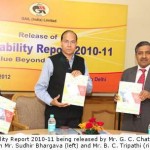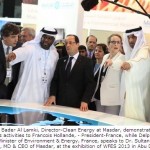
The Chairman of the Green Building Council of Australia, Mr. Tony Arnel, and the Chairman of the India Green Building Council, Dr. Prem Jain, signed a Memorandum of Understanding (MoU) today at the annual Indian Green Building Congress in Chennai.
“This MoU is a ground-breaking project that could give Australian companies an edge in the rapidly growing Indian construction market,” Mr. Arnel said.
“According to Austrade, more than 15 million homes, about 1,000 shopping malls, 100 million square feet of offices and 500 townships, along with airports, hotels, hospitals and schools, are set for construction in India by 2011-2012. A major component of this is sustainable building and construction with that section of the market having almost trebled on average every year since 2003, with more than 25 million square feet to be constructed in India during 2012 alone.”
“McGraw Hill Construction reports that India’s total construction market is worth more than $ 215 billion and Edelweiss Capital estimates the commercial building market is growing at 25-30 per cent each year, spurred on by the lifting of restrictions on foreign investment in the past couple of years,” Mr. Arnel said.
“This is creating huge opportunities for Australian investors, developers and service providers, who have strong expertise in green building.”
“The Indian Government is looking for ways to reduce greenhouse gas emissions while maintaining economic growth and improving the quality of life in Indian cities. It is well-established that the building sector offers the lowest-cost carbon abatement opportunities – green buildings often pay for themselves through energy savings – while also offering a better quality urban environment,” Mr. Arnel said.
“Greenhouse gas emission savings from improved energy efficiency in developing countries also potentially qualify for recognition as carbon offsets, and this will be the focus of the collaboration between India and Australia through this MoU.”
“The Indian Green Building Council will select a private sector developer’s building project in India, where the emissions will be measured through application of the Common Carbon Metric being developed by the World Green Building Council.”
Mr. Arnel said that although progress toward a post-Kyoto international framework for greenhouse gas emission trading had stalled, offsets could be sold through the UN’s Clean Development Mechanism (CDM) or voluntary trading schemes. Purchasers include companies and/or governments in the developed world wanting to offset their emissions.
“Carbon offsets can be worth even more than the savings from energy efficiency. Indeed, at current CDM prices of about A$20 per tonne of CO2, the available offsets are worth about twice as much as the value of the energy savings. Companies who know how to claim them will have a competitive advantage,” Mr. Arnel said.
To date, few building projects have been able to qualify for offset credits because there has been no simple, agreed means of measuring and gaining offsets from buildings. The WorldGBC’s Common Carbon Metric could redress this. It will potentially allow the rating tools of green building councils around the world to be used to measure greenhouse gas emission reductions on green building projects, and so enable sustainable building projects in developing countries to sell offset credits into the CDM or other voluntary carbon emission trading schemes.
Mr. Arnel said that tapping the offsets market for the building sector could give a major boost to reducing greenhouse gas emissions worldwide.
“Urbanization in India and elsewhere in Asia-Pacific is the largest single driver of global greenhouse gas emissions. Everyone on the planet has an interest in helping reduce this growth of emissions.”
“Australia can collaborate with India to address shared environmental concerns, while allowing both countries to enjoy the economic benefits of continued growth.”
A shift to green building would deliver many quality-of-life benefits for the growing Indian urban population. Uncontrolled growth of cities led to poor air quality, water, and waste management with resulting pollution impacts on physical and mental health, which are estimated by the World Health Organization (WHO) to cost some US $ 200 million a year in each of the large Asian cities.
“The use of carbon offsets to stimulate green building in India and other developing countries will lead to sustainable growth paths, employment generation and improved quality of life; thus, contributing to the UN’s Millennium Development Goals,” Mr. Arnel said.
A copy of the Memorandum of Understanding is available on request.

About the Green Building Council of Australia
The Green Building Council of Australia (GBCA) is Australia’s leading authority on green building. The GBCA was established in 2002 to develop a sustainable property industry in Australia and drive the adoption of green building practices.
The GBCA has more than 900 member companies who work together to support the Council and its activities. The GBCA promotes green building programs, technologies, design practices and processes, and operates Australia’s only national voluntary comprehensive environmental rating system for buildings – Green Star. For more information, visit www.gbca.org.au.
Source: GBCA Press Related October 7, 2010.
Related Feature:












